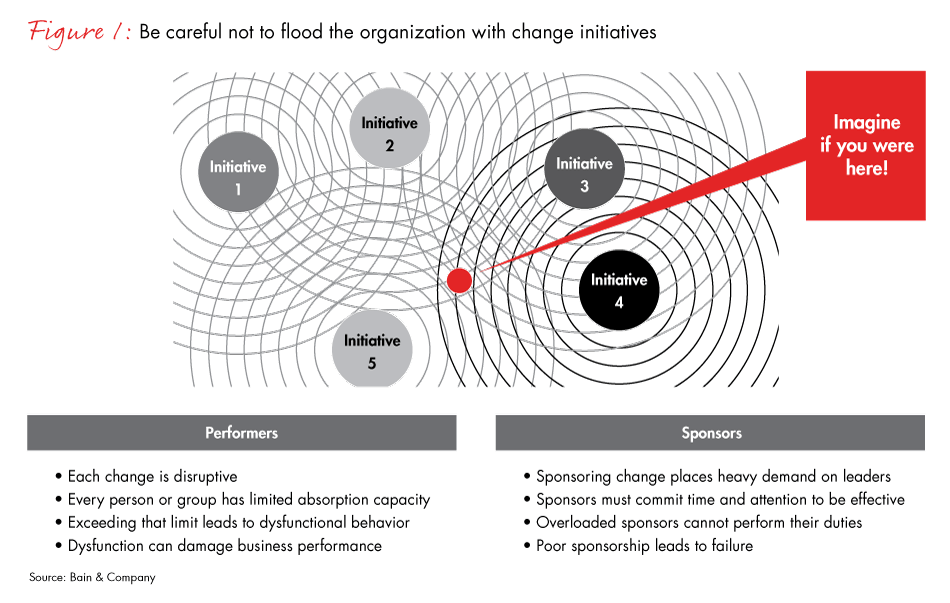Managing Change Blog
What’s the surest way for CEOs to lose their jobs? In a 2015 study of more than 1,000 corporate directors of companies whose boards had fired or pushed out a CEO, the No.1 reason was “mismanaging change.”
And what’s the No.1 reason why change programs fail? They have a scale and pace that, if improperly managed, simply overwhelm the organization. Similar to a flood, a poorly managed change program can sweep aside everything in its path, overwhelming employees and systems. Instead of making the critical changes that the company needs, such as speeding up response times in challenging markets, the organization begins to bog down. This is when boards start thinking about CEO tenure.
No company leader sets out to unleash a change flood, but it happens quite often. Indeed, only 12% of change programs deliver their expected results. From the vantage point of the C-suite, when leaders approve the change program, most items on the agenda look quite manageable. But down through the organization, across functions and geographies, there’s a different reaction—namely, cries of “initiative overload!”
David Michels, who leads Bain's Results Delivery® practice in Europe, the Middle East and Africa, outlines what leaders can do to turn the challenge of initiative overload into an opportunity for growth.
This should not come as a surprise. We know from behavioral science that people have a finite capacity to absorb change. This capacity is called resilience. We all have different levels of resilience, and as long as the change stays within reasonable bounds, all is well. But once the scale of change reaches flood levels and breaches our resilience level, we experience overload and our productivity plunges. We can no longer meet the standards of timeliness and quality that we used to maintain in our work. The result is frustrated employees, unwanted attrition, underserved customers and a lot of sand in the wheels of change.
How, then, can you avoid flooding the organization with too much change but also achieve your ambitious objective? There is an easy answer and a harder answer. The easy answer is to set priorities on your agenda rigorously, limiting the change to what can be accomplished without overload. This is easier said than done, but the process is straightforward: Decide to say no to some good ideas so that the great ones can flourish. Some executives use a one-in/one-out policy: For every new initiative added to the agenda, another needs to be axed. Then there is the Steve Jobs approach. He told his management team to reduce the list of priorities to the top 10. Then he crossed off numbers 4 through 10. “We can only do three,” he declared. Jobs’ approach was perhaps a bit extreme, but it was an effective way of getting rid of the clutter and taking things off people’s plates so that they could focus on the initiatives that would have the greatest payoff.

Change Management Insights
Change management has been around for decades, but more than 70% of change efforts fail. Bain’s Results Delivery® insights help companies to predict, measure and manage risk, starting on day one.
The harder solution goes much deeper and is more fundamental: It seeks to increase the capacity to manage change rather than limiting change to match capacity. This involves predicting where in the organization initiative overload might occur and channeling resources to those places to help absorb change. The executive team of a global consumer products organization, as part of its transformation, took the following approach: It grouped employees by their importance to driving the transformation and by the degree to which they would be affected by the change. The team mapped the results on a two-by-two grid. In the upper right-hand quadrant were the employees most likely to be overwhelmed: Their help was critical for delivering program value, and their functions faced a high degree of change. Then the executives mapped all the initiatives over time and overlaid them against who within the organization would actually have to perform the work. Through this exercise, the team was able to identify the places that would need the most help.
Armed with this valuable information, the organization used a number of tactics to increase its ability to absorb change. These ranged from adding resources in the areas of potential overload to altering the sequence of initiatives to create a more realistic critical path. The company also worked to raise the ability of business units and functions to manage change by filling key roles with more resilient talent, providing focused training and reinforcing more Agile behaviors—for instance, using discrete time-boxed sprints, product backlogs and regular huddles.
Clearly, leaders who set off change floods, without the proper systems in place, do so at their peril. The next time you see the warning signs of possible flooding, have the courage to say “no” to initiative overload. Instead, turn the challenge of flood management into an opportunity, by systematically building resilience and agility into your organization.

David Michels leads Bain & Company's Results Delivery® practice in Europe, the Middle East and Africa.
